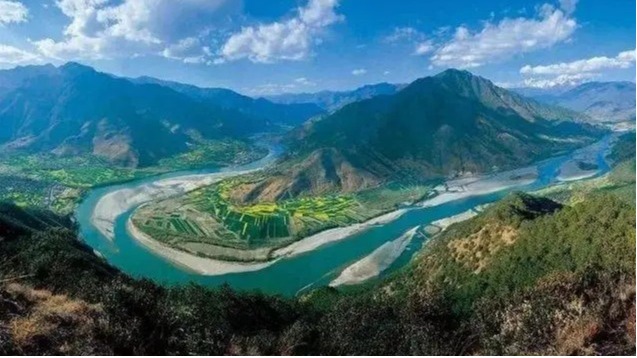The Yangtze River culture is a convergent cultural system based on the special natural and human geography of the Yangtze River basin and the level of development of the productive forces, and it is the sum and agglomeration of the cultural characteristics and cultural assemblage of the Yangtze River basin. Sichuan, Chongqing, Hubei, Hunan, Jiangxi, Anhui, Jiangsu, Zhejiang, Shanghai, Yunnan, Guizhou, Guangxi, Guangdong, Fujian and other provinces and regions are the main streams or tributaries of the Yangtze River system, and they belong to the same southern Chinese cultural system in terms of culture. The Yangtze and Yellow River cultures are the two most representative and influential main cultures of Chinese civilization.
In the "diverse and integrated" Chinese civilization, the Yangtze and Yellow River cultures are undoubtedly the two most representative and influential main cultures. Although they each have their own different cultural connotations, forms, roles and historical development processes, they are not isolated from each other. During the thousands of years of development of Chinese culture, they have not only collided with and confronted each other, but also influenced, infiltrated and complemented each other, making them two parallel developing cultural systems. This kind of cultural connection, which is complementary to each other in terms of strength and flexibility, yin and yang, has naturally formed a cultural unity in terms of bloodline, which has become the basis for the development of the Chinese culture, and has made the Chinese culture of the great unification show splendid and various colors, and has also given far-reaching influences to the overseas cultures in the vicinity.
The so-called cultural zones are geographical areas with similar or identical cultural qualities, also known as cultural geographic zones. In the same cultural area, the language, religious beliefs, art forms, living habits, moral concepts and psychological, character and behavior of its inhabitants are consistent, with strong regional cultural characteristics. As a regional categorization of cultural traits, cultural districts and administrative districts do not belong to the same concept. An administrative district is a regional unit of administration, while a cultural district is a spatial carrier of different cultural traits. The former is artificially divided, while the latter is formed in a certain geographical environment. Therefore, we cannot simply apply the concept of administrative districts to replace cultural districts, or we will not be able to draw correct conclusions. Of course, there are some administrative divisions in accordance with a certain geographical environment, coupled with the continuity of the administrative divisions of successive dynasties, over time also has the nature of the cultural district, such as Sichuan Province, the culture of Ba Shu is a typical representative. But many administrative regions in ancient times are very different with cultural areas, such as Jiangsu Province, although it is an independent administrative region, but culturally set the Yangtze River as its boundary, and it was divided into southern Jiangsu and northern Jiangsu, which can not constitute a unified cultural area. And the southern Jiangsu region and the Hangjiahu region in northern Zhejiang have similarities in culture due to the same geographical environment, so they should be considered as one region. Another example is that Anhui Province is also an independent administrative region, but culturally it can be divided into three parts, namely, Huaibei, between Jianghuai and Jiangnan, according to the water system of Huaihe River and Yangtze River. Huaibei is located in the Yellow River basin, with a strong atmosphere of the Central Plains culture; while the Huizhou area in Jiangnan, due to its proximity to the Taihu Lake basin, should be classified into the system of Wu-Yue culture, and become a branch of the Jiangnan culture - Huizhou culture. The Jianghuai area, on the other hand, is characterized by the transition from the Wu-Yue culture to the Central Plains culture, but most of it still has elements of the Yangtze River culture.
At the same time, cultural area is also a dynamic concept, which is constantly developing and changing. With the development, diffusion and integration of the Yangtze River culture, some old cultural districts declined or disappeared, and some new cultural districts appeared. For example, in modern times, when the Sichuan and Jiangxi cultural districts were in decline or disappeared, the Shanghai and Lingnan cultural districts rose rapidly. In addition, the cultural qualities of cultural districts also have a process of constant change. In the process of cultural development, it constantly eliminates the old factors, renews and reforms, self-organizes and self-improves, and forms and creates a new cultural area that is completely different from the nature and appearance of the traditional cultural area. Therefore, we should not only take into account the characteristics of traditional cultural areas, but also carefully study and analyze the formation, development and changes of new cultural areas.
Based on the above understanding, we believe that in the Yangtze River culture as a whole, it can be divided into different subcultures according to the local and regional diversities within the basin: Ba Shu culture area, Yunnan culture area, Guizhou culture area, the two lakes culture area, Jiangxi culture area, Wu-Yue culture area, Jiangsu-Huaikou culture area, Min culture area, Gui culture area and so on.
To summarize, we believe that the Yangtze River culture is a huge cultural system with Ba Shu, Chu and Wu Yue cultures as the main body and sub-cultures such as Dian, Qian, Gan, Min and Huainan cultures as the sub-cultures, and that these different cultural communities converge under the same cultural rules to form a common cultural body —— the Yangtze River culture.
